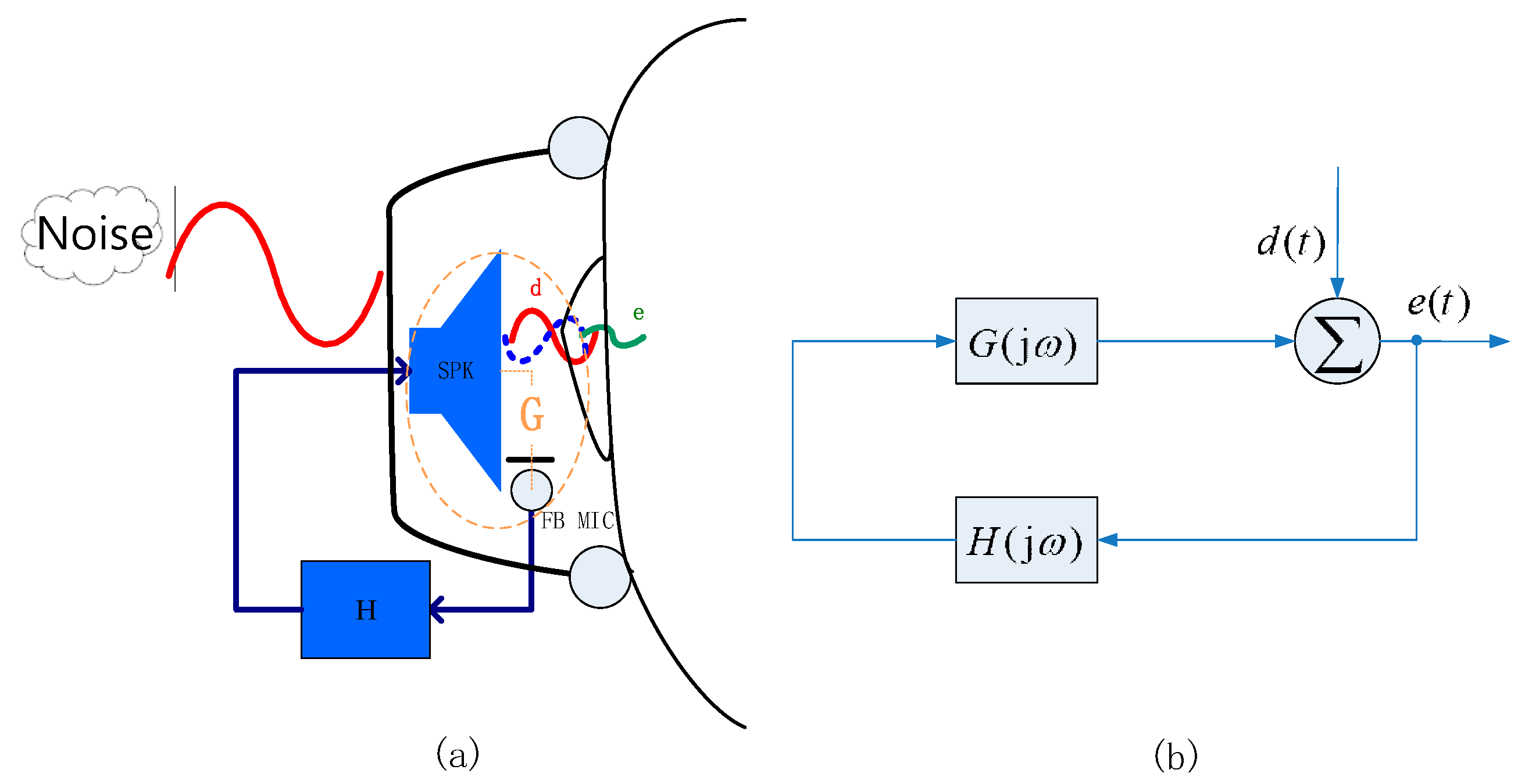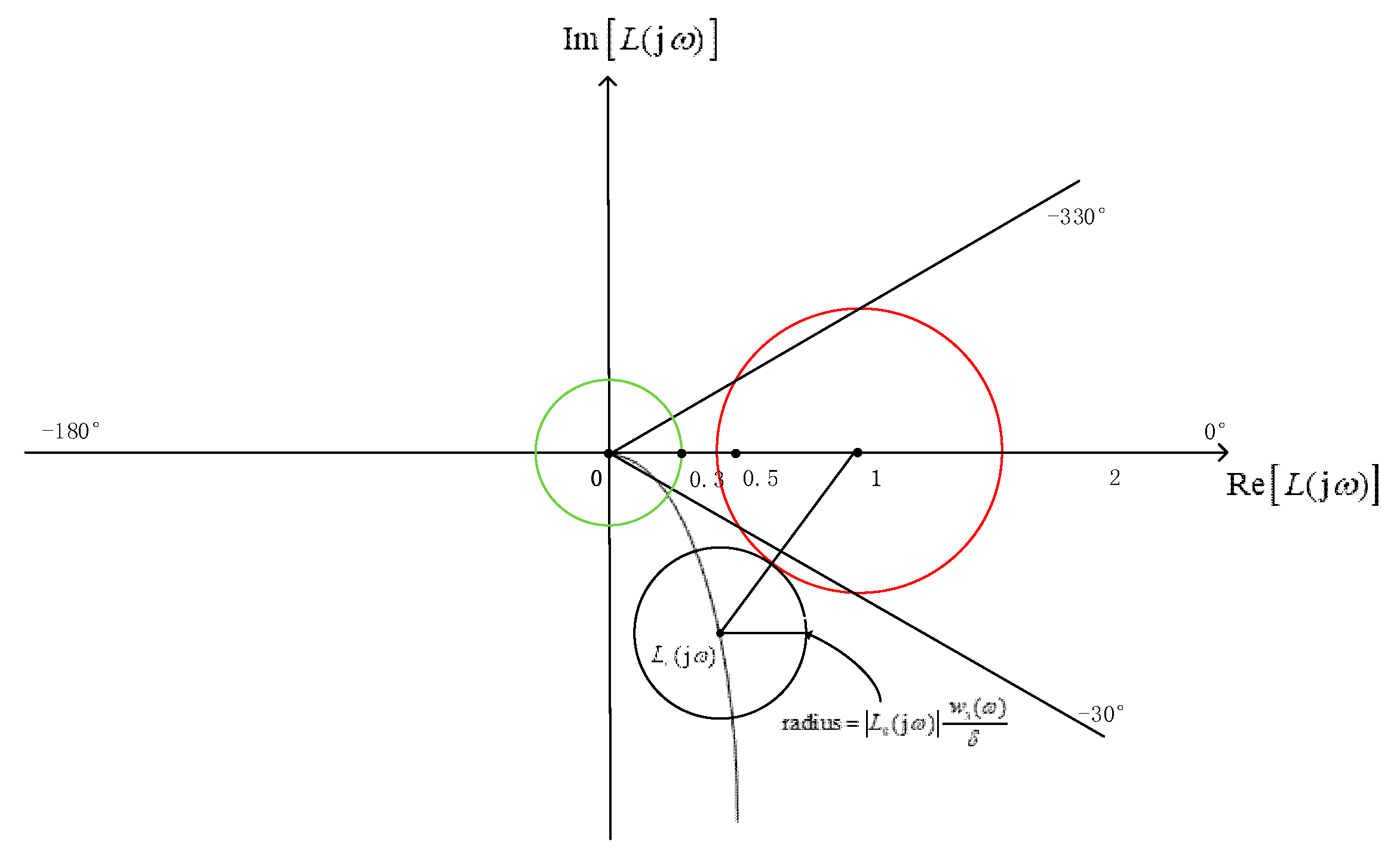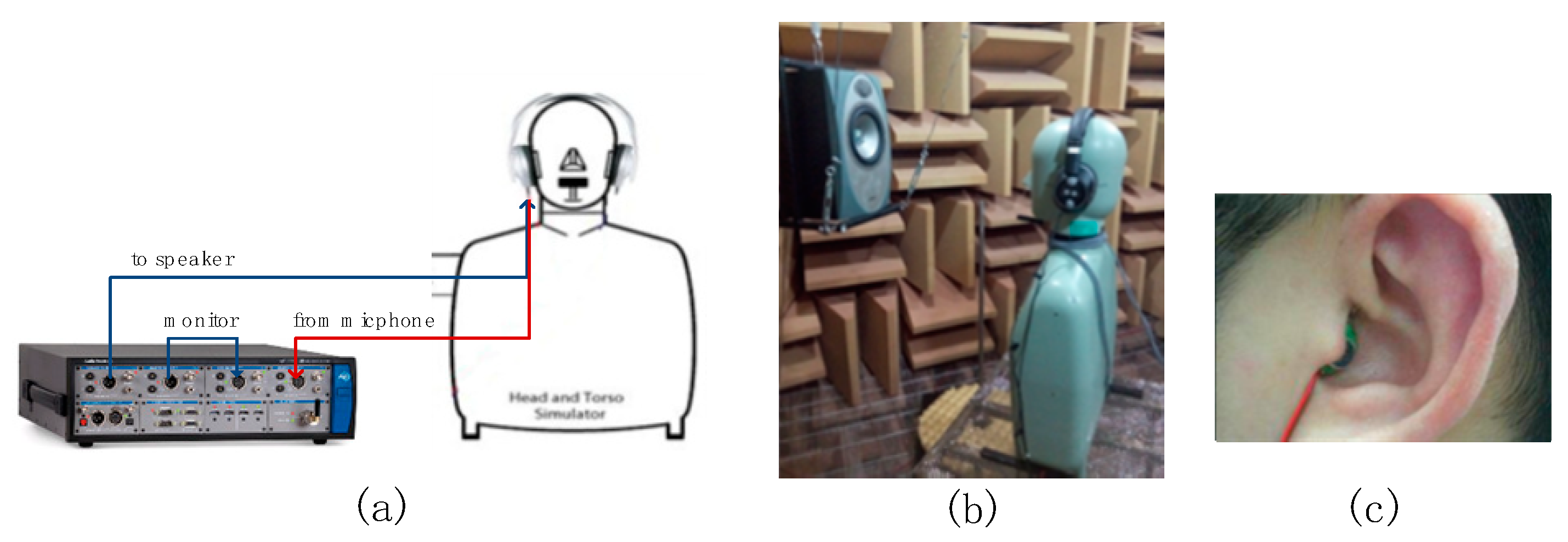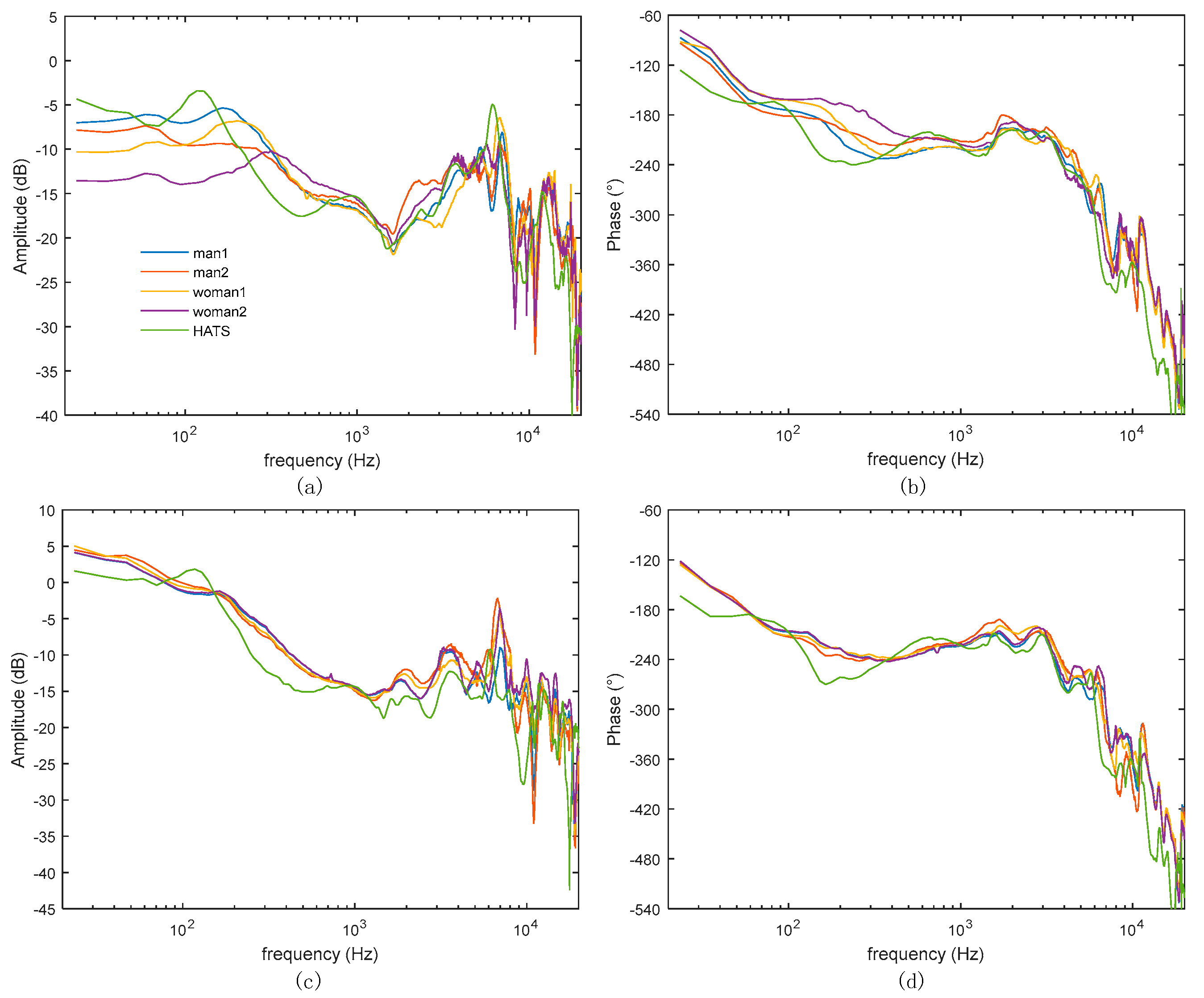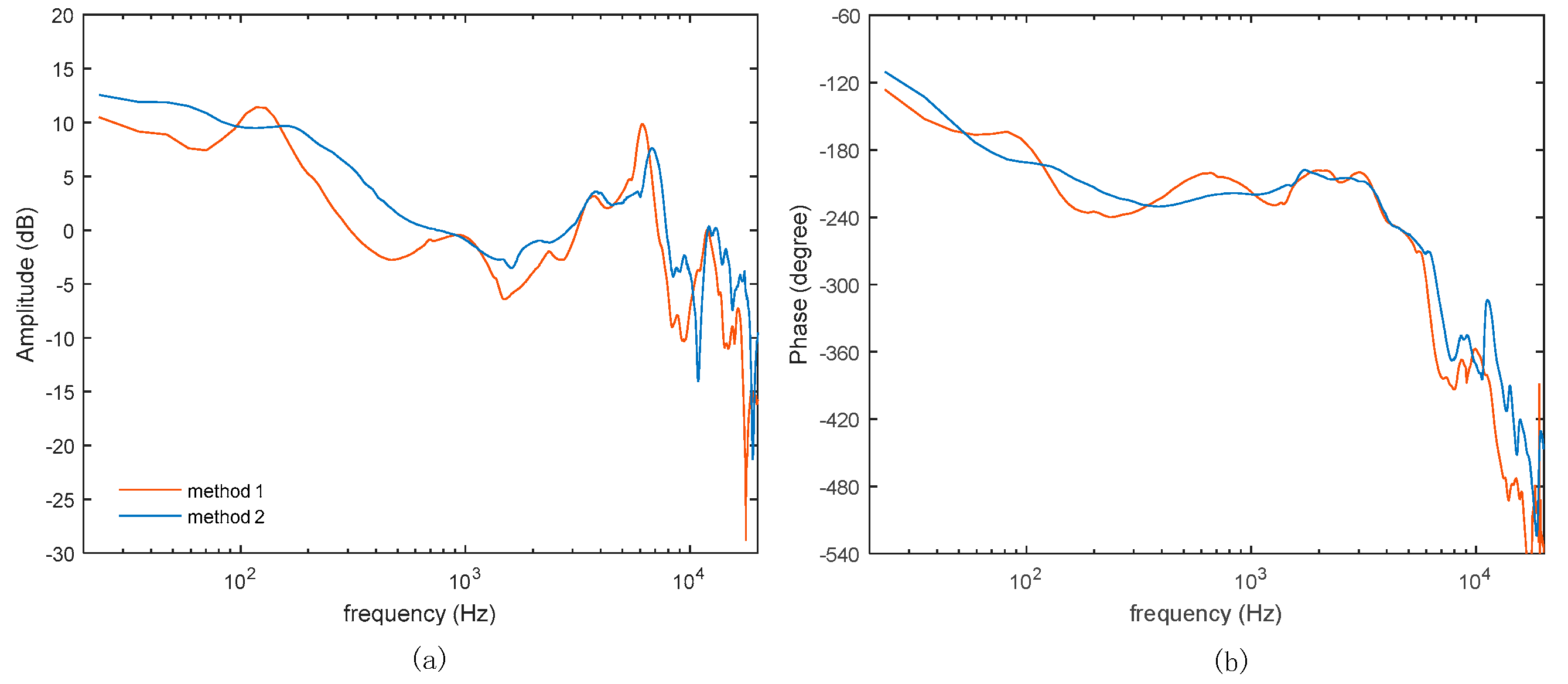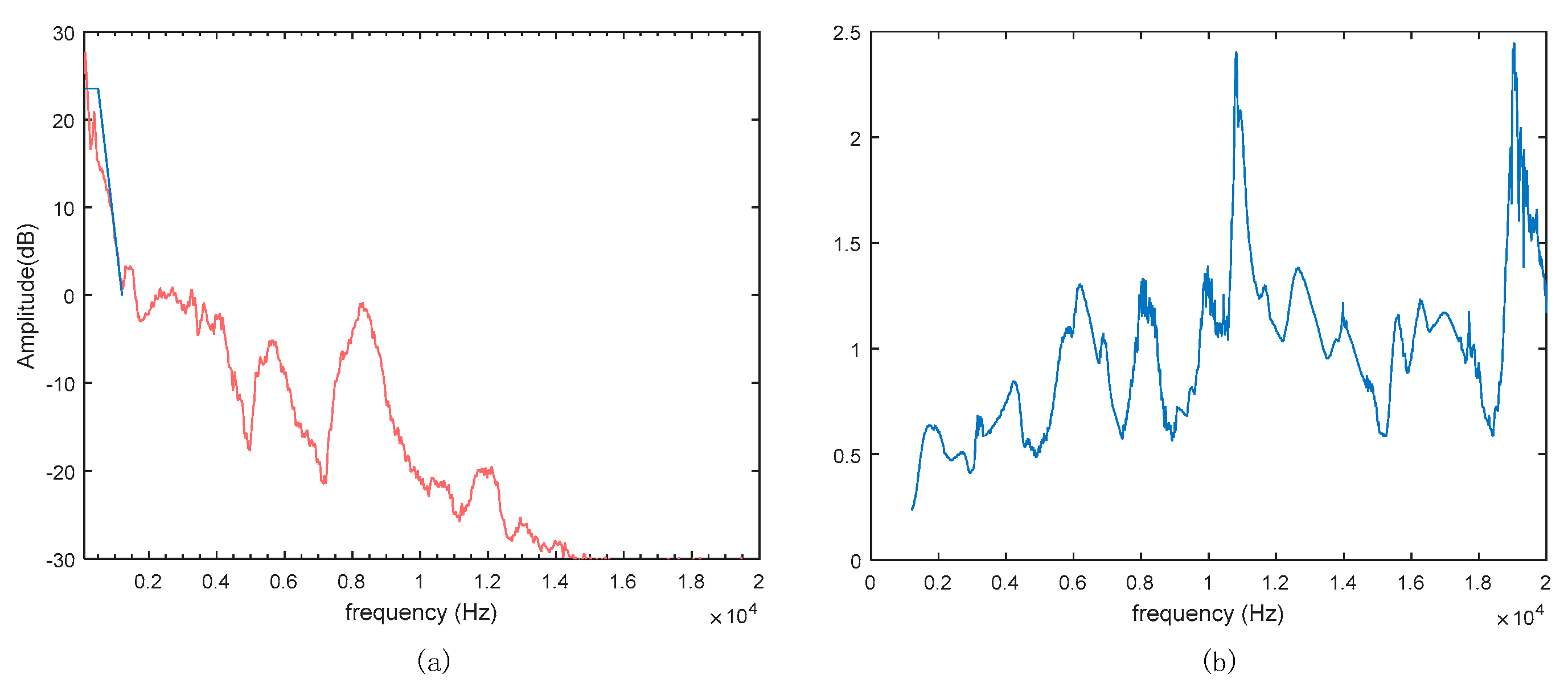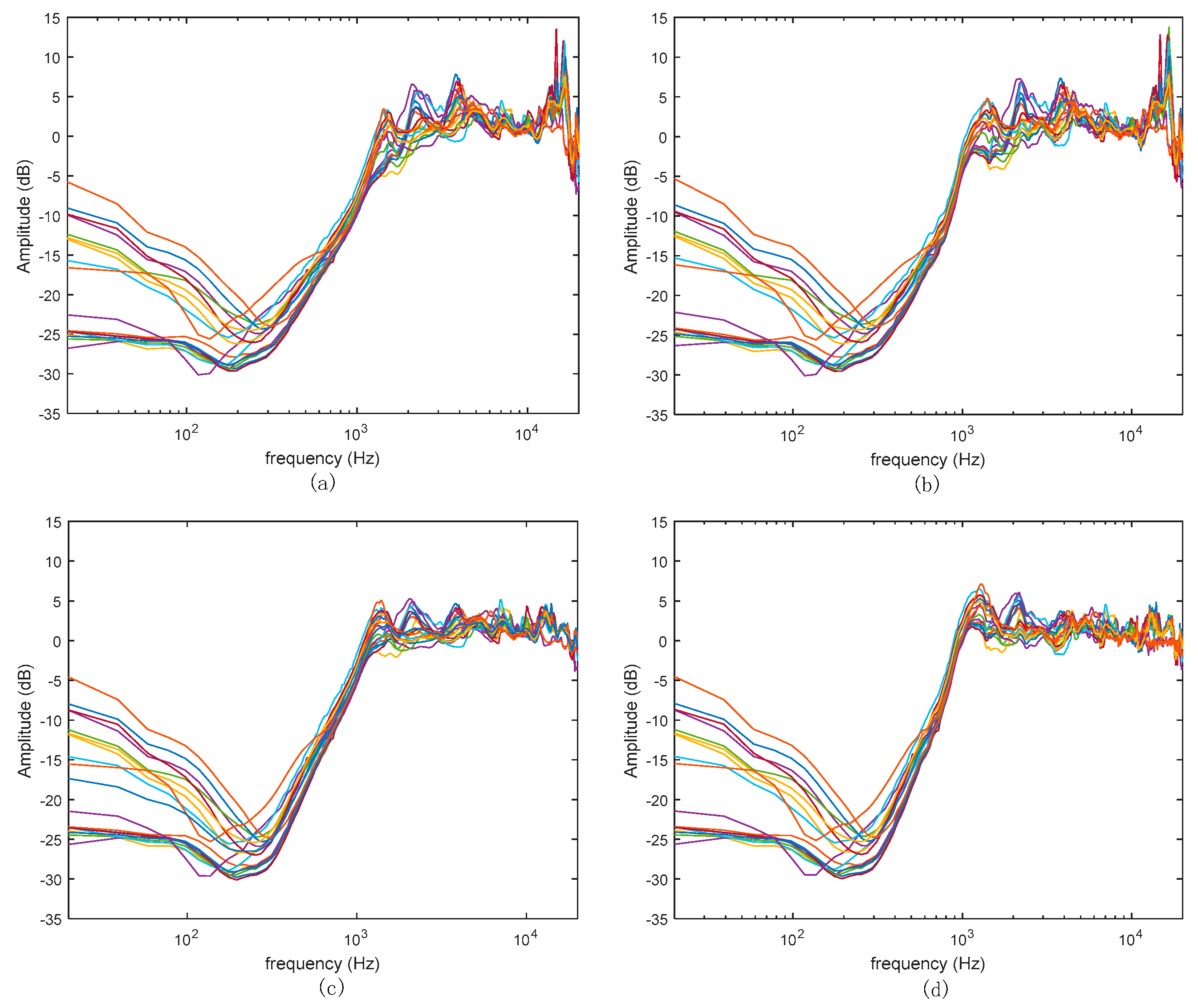1. Introduction
In the field of commercial headphone, ANC has become a common application [
1]. Controllers in this realm are classified into two categories based on the time-variability of their filtering coefficients: fixed controllers and adaptive controllers. Fixed controllers contribute to reduced computational demands and extended battery life, thereby improving the standby time of headphones. Recently, Bai et al. [
2] found that com-pared to adaptive controller, a fixed controller had achieved satisfactory noise reduction performance and signal tracking quality, which are highly valuable merits in practical applications.
ANC controllers are mainly divided into feedforward, feedback, and hybrid con-trollers in terms of their control structures. Notably, the feedback control strategies have been paid particular attention in long-history research [
3]. The introduction of feedback mechanisms leads to two primary issues: firstly, according to the Bode sensitivity integral theorem, reducing low-frequency noise often results in the amplification of noise at other frequencies, a phenomenon commonly known as the "waterbed effect" [
4]; secondly, the stability of the system varies across different usage environments, primarily owing to the impact of secondary path uncertainty [
5,
6] on system stability. Therefore, the basic principle of designing a feedback controller for ANC headphone is to maximize the low-frequency noise reduction performance while robustly maintaining the stability of the system, and to limit the noise enhancement at high frequencies.
Rafaely [
7] pointed out that owing to the additional delays in a digital system, the bandwidth often becomes limited. The controllers for ANC headphones were initially implemented using analog circuits, with various design methods proposed by re-searchers such as Bai and Lee [
8], Pawełczyk [
9], and Hu et al. [
10,
11]. However, ana-log circuits have such drawbacks as significant discrete component errors and temperature drift, deteriorating the noise reduction performance and even system stability, so precise and low-power controller designs are needed in practical applications.
The uncertainty of the secondary path exceeds the deviation of the controller, of-ten leading to stability issues. The modeling errors of the secondary path may deteriorate the stability bound of the system [
12]. Eriksson and Allie [
13] first attempted to use random noise for online identification of a system's secondary path, while Morgan [
14] proposed a prediction method applicable for both online and offline identification. However, the method of online identification with added noise is not suitable for ANC headphones as the identification error signal may contaminate the error signal of the noise reduction system itself. Given the close relation of headphone systems to human hearing, the presence of identification noise is unacceptable. Gan discussed using mu-sic or speech signals present in the headphone system as identification signals for the secondary path [
15]. More recently, Yang et al. [
16] proposed a method to control the identification error energy, and the system stability was significantly improved, although further research is required for headphone applications.
In practice, the transfer function of a headphone's secondary path is usually obtained through offline identification, and then is constrained by disk [
17]. The uncertainty in the secondary path manifests mainly in the variance between a single head-phone's use by a single subject or a dummy head, in terms of wearing and removing the headphones, and the differences in multiple wearings by one or multiple subjects. Zhao et al. [
18] noted that headphone puton and takeoff introduces large variance in the transfer functions of the secondary path, affecting the convergence of the adaptive system, and this variance can be reduced using the IMC feedback control implemented with analog circuits. Yu and Hu [
10] used the results of four wearings to establish the controller's objective function and constraints, and then created an analog circuit con-troller. Guldenschuh and Callafon [
19] found that the low-frequency drastic changes in the secondary path when putting on and removing headphones could be identified by an adaptive filter, based on which a feasible weighting coefficient update rule was established through experiments. Leading companies like BOSE, SONY and Apple have adopted proximity sensors offering quick and accurate responses in their ANC headphones to monitor the states of wearing and removal [
29,
30,
31], and this approach can replace algorithmic detection from an engineering application perspective, reducing the algorithm's consumption of system power. For the latter case, Ti’s engineer Krishnamurthy et al. [
20] used the average result of 10 real subjects to obtain the secondary path transfer function, and employed a smaller update coefficient to handle the greater variance. Benois and Zolzer [
21] constructed different weighting coefficient constraints using real secondary path data from two dummy heads and six subjects wearing the headphones at three different angles, and used the SQP algorithm to de-rive the FIR filter and compared the results. Hilgemann and Jay [
22] built an uncertainty model using the real part of 78 secondary path transfer functions tested on a single subject, and also used the SQP algorithm to calculate the FIR filter.
However, the implementation methods mentioned above either use analog circuits or FIR filters. Analog circuits have significant errors, and the FIR controllers will introduce additional delay and cannot meet the requirements of current ANC head-phones. Wang et al. [
23] and An et al. [
24] implemented controller designs using the IIR filters, and optimized them with the genetic optimization algorithm (GA) combined with the Nelder-Mead (NM) algorithm and differential evolution (DE) algorithm, respectively. In the former controller, the application of twice optimization increased the system complexity, while the latter controller based on the DE algorithm operates directly in continuous space, facilitating the global minimum search but bringing high computational demand [
25]. The GWO [
26] algorithm and its improved version, IGWO, as typical representatives of swarm intelligence algorithms, are characterized by their simple structure, minor parameter adjustment, and ease of implementation. They contain an information feedback mechanism, and a balance is achieved between local optimization and global search, thus offering good performance in both solution accuracy and convergence speed [
27].
In this paper, a method is proposed to design feedback ANC headphone controller. A new secondary path uncertainty constraint is proposed based on the results of multiple wearing tests on real subjects and dummy head. This constraint is applied in the process of optimizing the controller, so that new subjects can get stable noise reduction and moderate waterbed lift when using the headphone. In
Section 2, a safety factor and a waterbed suppression factor are introduced into a proposed uncertainty constraint, which is integrated into the H2/H∞ framework to obtain a feedback control strategic function. In
Section 3, the control strategic function is optimized by the IGWO algorithm to obtain the optimal controller composed of cascaded biquad IIR filters, and the noise reduction performance is simulated in two cases with or without the proposed uncertainty constraint. The reliability of the proposed method is validated based on the measured results of experimental test. Finally, conclusions are drawn in
Section 4.
2. Design Method of Feedback Controller
2.1. Parametric Filter
A biquad IIR filter has the basic form as follows:
The form of each filter coefficient uses the peaking or high-shelf prototypes, whose coefficients [
28] are shown in
Table 1 below.
In the table,
where
is the predefined sampling frequency. Among the other variables,
denotes the center frequency in Hz;
represents the steepness of the central frequency and is a dimensionless number; and
denotes the gain of each filter, in dB. These three parameters can uniquely characterize a biquad IIR filter. A positive
means the filter shape is peaking or high-shelf, and a negative
means notching or low-shelf shape.
The feedback controller is composed of cascaded biquad IIR filters:
where
is the nth biquad filter formed by parameter
and
, and n=1 2 ...N;
is a real number representing the total gain of the cascade controller. This feedback controller is determined by the following parameter vector:
2.2. Feedback Controller
In
Figure 1a, the secondary path
defined in the acoustic domain goes from the headphone speaker (SPK) to the feedback microphone (FB MIC) in the front cavity of the headphone, corresponding to the controller circuit
consisted of microphone preamplifier, feedback filter, and power amplifier in the electronic domain. The external noise passing through the headphone shell into the chamber is the primary noise
. After the controller is turned on, the remaining error noise is
. In
Figure 1b, where
and
are the primary noise signal and error noise signal, respectively,
and
are the transfer functions of the secondary path and controller circuit in the complex frequency domain, respectively.
The system sensitivity function is defined as the transfer function between the primary noise signal and the error noise signal, as follows
where
is the open-loop transfer function of the system. In addition, the complementary sensitivity function of the system is defined as follows
From the point of view of noise suppression, when the primary noise exists, the error signal picked up by the error microphone should be the smallest in terms of mean square.
where
represents the mathematical expectation,
and
are the power spectral densities of
and
, respectively.
The objective function and constraint of the H2/H∞ framework is set as follows
where
is the root mean square value of the power spectral density of primary noise, and
is the limit of noise lift at each frequency.
From the perspective of system stability, an open-loop transfer function should have a certain Amplitude Margin, defined as
, and Phase Margin, defined as
. The stability constraint of the feedback system is set as follows
For an invariable specified secondary path, the above objective function and constraints, defined as Method 1, can ensure that the system can achieve a good balance between noise reduction and waterbed lift, but the secondary path in a real system has uncertainties, so it is necessary to add uncertainty constraint.
2.3. Secondary Path Uncertainty Constraint
The uncertainty discussed in this paper is described by multiplicative uncertainty. The multiplicative form of the secondary path can be expressed as
where
is the initial secondary path transfer function, and the expectation of
represents the degree of multiplicative uncertainty:
From a statistical point of view, the degree of uncertainty is minimal when the initial secondary path is exactly the expected value of the secondary path . In practical applications, we should test as many secondary path transfer functions as possible to improve the scope of system stability. In case of limited numbers of measurement, using the mean value of the secondary path transfer function obtained from all tests helps to reduce the degree of system uncertainty.
In order to ensure the stability of the system in each actual scenario, set as the greatest degree of uncertainty , and because the measured data are always limited, a safety factor (where ) is set to improve the robustness of the system stability to uncertainty. The larger is the number of test samples, the closer is to 1. The weighting coefficient of uncertainty constraint is denoted as .
As shown in
Figure 2, the open-loop transfer function is restricted to the disk whose center is the open-loop transfer function
and whose radius is
, resulting from the fluctuation of the secondary path transfer function. The Nyquist stability condition requires that all points in the disk do not pass through the point
, and the radius
is less than the distance
between the center
and
.
In the Nyquist plot, noise rising is more than
in the red disk with center
and radius
, which is defined as the waterbed suppressing factor. The open-loop transfer function is restricted in the black disk. When these two disks are dis-intersected, the noise rising caused by uncertainty is less than
, and hence an uncertainty constraint is proposed as below:
Equation (14) considers the constraint conditions of secondary path uncertainty. In order to prevent the bandwidth of noise reduction being too narrow, should be less than . When , the constraint has only met the Nyquist stability but not limit the waterbed lift for the secondary path uncertainty.
2.4. Control Strategic Function
Use a specified measured secondary path transfer function and a feedback controller with parameter vector
to build a feedback control strategic function. This procedure is denoted as Method 1,
Considering the uncertainty of the secondary path, use the mean of multiple measured secondary path transfer functions and a feedback controller with parameter vector
to rebuild the feedback control strategic function with the uncertainty constraint. This procedure is denoted as method 2,
where,
is the unit step function
In Equation (16), the first term on the right side represents the amplitude of the sensitivity function, indicating the noise reduction performance. It reaches the minimum when the noise reduction is equal to the frequency characteristic of primary noise , and the best feedback reduction is achieved.
The second term on the right side of Equation (16) represents the constraint on the Nyquist stability. If the open-loop function does not meet the conditions regarding amplitude margin or phase margin , this term is multiplied by a penalty factor , which is a positive real number.
The third term pertains to the constraint on waterbed lift of the mean of second paths. If the noise enhancement exceeds a preset upper limit , this term is also multiplied by another positive real number penalty factor .
The fourth term relates to the uncertainty constraint of the secondary path. If the constraint is broken through, this term is multiplied by a positive real number penalty factor . If a single specified secondary path design is used, this term of the strategic function is omitted.
In this study, the IGWO algorithm is used to solve the control strategic function. The initial parameter range can be customly set based on experience, thus offering good performance in terms of solution accuracy and convergence speed. It is suggested that the optimization process should be repeated for multiple times to find the global optimized filter coefficients.
